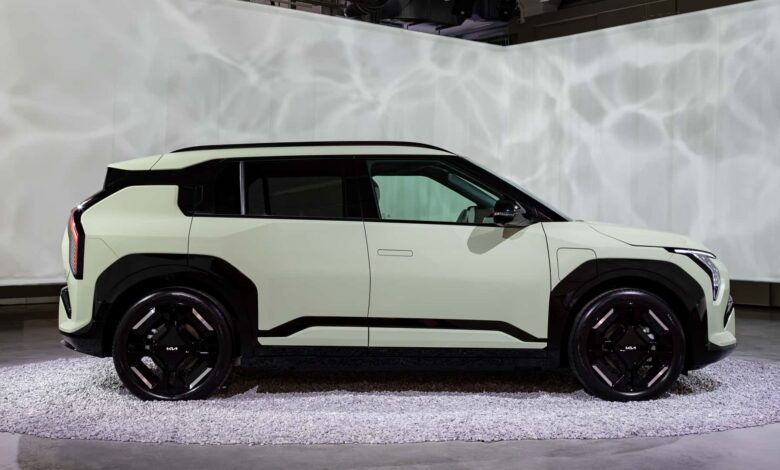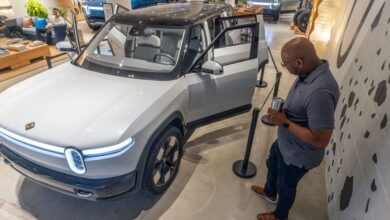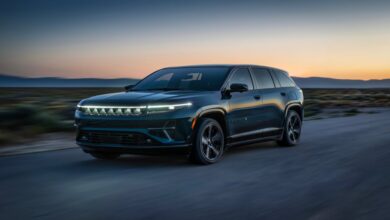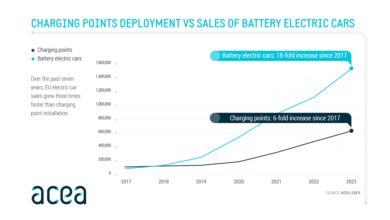The $35,000 Kia EV3 Is The Electric Car America Has Been Waiting For

It can be tough to get excited about new electric cars when so many are completely out of reach for regular people. Just look at the Chevrolet Silverado EV pickup we just tested. That thing costs $96,000. Not exactly what we’d call attainable.
Kia’s just given Americans an EV to get jazzed about actually buying: the $35,000 EV3 crossover. The new model, which Kia said will hit the U.S. after 2025, is welcome news for car shoppers who’d love to go electric but aren’t comfortable dropping $40,000 or $50,000, which has been the going rate for a competitive EV. Bigger picture, it’s a step in the right direction for EV adoption on the whole, which has suffered from high sticker prices and a lack of options.
Kia wants to make “EVs for all”
Kia and its corporate parent Hyundai have emerged as some of the fiercest competitors in the new EV market. The EV3 will join Kia’s other electric offerings: The EV6 and Niro crossovers and the three-row EV9 SUV.
Stylish, feature-filled and relatively inexpensive, the EV3 aims directly at a big gap in the current electric car market. The cheapest Tesla starts at $38,990. There are some electric models that cost less than that, but they’re generally outdated or compromised in one way or another. The EV3 arrives as one of the first truly modern, lowish-cost EVs.
The Chevrolet Equinox EV, which launched last week, is another bright spot. A $34,995 version that offers over 300 miles of estimated range and qualifies for the $7,500 tax credit will be available to order later this year. The EV3 would need to be made in North America to qualify for the credit, which Kia said it is evaluating for exactly that reason. Either way, you’ll be able to benefit from a $7,5000 if you lease the Kia, so it should still be extremely affordable for lessees.
The EV3 offers up funky, angular styling that fits right in with its higher-end options like the three-row EV9. Kia also touts a targeted range of 300 miles (though that should cost more than the base price), a ChatGPT-powered voice assistant and dual 12.3-inch screens just like in its more upmarket EVs.
“I think it works well on a lot of fronts,” said Jeff Schuster, global vice president of automotive research at GlobalData. “This should be a vehicle that does well, I would expect, in the U.S. market.”
Importantly, Schuster added, $35,000 isn’t just a good price for an EV. It undercuts much of the conventional car market as well, where prices have risen significantly in recent years.
The EV3 has the potential to get a lot more people into electric cars and out of smog-spewing combustion vehicles. Study after study have shown that high upfront costs are among the top deterrents keeping consumers from buying EVs. In a recent survey of potential car buyers, Edmunds found that 47% of people want an electric car that costs less than $40,000. That appetite doesn’t jive with today’s marketplace.
Particularly during a time when EV sales growth has slowed down, a lower-cost option like the EV3 could see success, said Jessica Caldwell, head of insights at Edmunds. But price won’t be a silver bullet for sluggish sales, she said. The EV market is shifting away from early adopters, who’ve largely been satisfied, and toward mainstream buyers. Those people have concerns beyond price, Caldwell said, like access to charging infrastructure.
Still, looking ahead, a variety of EVs at every price point will be necessary for the shift away from fossil fuels. EVs already cost about as much as combustion vehicles when you factor in the total cost of ownership over a vehicle’s lifetime, according to RMI, a clean-energy think tank. But buyers don’t tend to think that far ahead. The next “tipping point,” according to RMI principal Daan Walter, is parity in sticker price.
“That is really when you see the market go into overdrive,” he told InsideEVs.
The $35,000 EV3 is a step in the right direction, but comparable gasoline vehicles can still be had for less.

Lower-cost models aren’t just what people want. They’re crucial for the complicated, expensive EV transition the world’s automakers are undertaking. Lower prices drive higher manufacturing volumes, which in turn produce greater economies of scale. In these early days, automakers like General Motors and Ford are losing money on EVs. Kia says its electric lineup is profitable.
“I think those that will be able to improve efficiency in manufacturing and bring down the cost to the consumer are the ones that are going to win,” Schuster said. “And I think this is a good step for Kia.”
Budget-conscious Americans can expect some more similar options to hit the market over the next several years. A new version of the popular Chevy Bolt is planned for 2025 to slot below the Equinox EV. Ford is working on a novel EV platform that will reportedly deliver a low-cost EV by 2026.

The EV3 will slot in at the bottom of Kia’s U.S. electric lineup. The three-row EV9 SUV is on the other end.
But it’s not all sunshine and rainbows, folks. The Volvo EX30, another promising $35,000 entrant, was supposed to hit U.S. shores this year. Biden’s new tariffs on Chinese EVs could dash those plans, as the EX30 is built in China. Not to mention, those tariffs will keep out inexpensive Chinese offerings like the BYD Seagull, which will be sold in Europe for under $21,500.
For years, people expected industry leader Tesla to come out with an entry-level EV below the Model 3. Those plans have been all over the place lately, but last we checked a cheaper Tesla is planned for next year sometime. We’ll have to see how that pans out.
We won’t know precisely how good a deal the EV3 is until we learn more about its EPA-estimated range and pricing. On paper, the baby EV seems to be a standout option for people who want a small, appealing electric crossover that doesn’t break the bank. And it once again solidifies Kia and parent company Hyundai as the carmakers to watch during the EV transition.
Got a tip? Contact the author: Tim.Levin@InsideEVs.com



